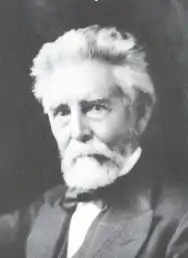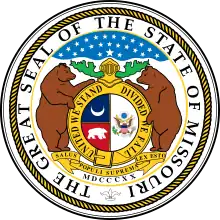Norman Jay Coleman
Norman Jay Colman (May 16, 1827 – November 3, 1911) was a politician, attorney, educator, newspaper publisher, and, for 18 days, the first United States secretary of agriculture.
Norman Coleman | |
|---|---|
 | |
| 1st United States Secretary of Agriculture | |
| In office as Commissioner April 3, 1885 – February 14, 1889 as Secretary February 15, 1889 – March 6, 1889 | |
| President | Grover Cleveland Benjamin Harrison |
| Preceded by | George B. Loring |
| Succeeded by | Jeremiah Rusk |
| 17th Lieutenant Governor of Missouri | |
| In office January 12, 1875 – January 8, 1877 | |
| Governor | Charles Henry Hardin |
| Preceded by | Charles Phillip Johnson |
| Succeeded by | Henry Clay Brockmeyer |
| Personal details | |
| Born | May 16, 1827 Richfield Springs, New York, U.S. |
| Died | November 3, 1911 (aged 84) St. Louis, Missouri, U.S. |
| Political party | Democratic |
| Spouse(s) | Clara Porter Catherine Wright |
| Education | University of Louisville (LLB) |
Louisville, Kentucky
Colman was born in Richfield Springs, New York, to son of Nancy (Sprague) and Hamilton Coleman. He later moved to Kentucky to become an educator. While in Louisville, he took the time to attend law school and received a law degree from the University of Louisville Law School in 1849.
Greenville, Indiana
In 1850, Colman became the first principal in Greenville when the Floyd County Seminary opened in Greenville, Indiana. The school was funded by raising $2,000 with Greenville residents contributing an additional $800 to secure the school for their town. For this sum, it was possible to erect a large 2-story brick building on land donated by Isaac Redman. One of the trustees appointed to oversee the new school was John Baptiste Ford of Greenville who was a prominent resident and famous for his glass works.
Colman served as Principal in Greenville for two years. In 1852, the Hoosier legislature approved the first laws establishing the public school system. This spelled the end of the older county seminaries for the new law provided that they be closed and their assets turned over to the new public school systems. Some 100 students had been attending the school paying tuition of $4 to $8 a semester and finding board and lodging in Greenville homes at $1 a week.
The closing of the Seminary proved to be the end of Colman's teaching career. During Colman's time in Greenville, he met Clara Porter and married in 1851. Clara was the daughter of Daniel Porter who is best known for Porter's Public House in Greenville which was a notorious hotel, bar, and social spot. Together they had two children; Laura Kate Colman (1860) and Francis Porter Colman (1862).
Missouri
Colman then moved to Missouri, ostensibly to farm. He was elected as an Alderman for St. Louis city's 5th ward as a Whig in 1854 and 1855[1] In 1855 he founded the Valley Farmer newspaper. As a result of his publication, Colman became a prominent figure in Missouri farming circles, which set the path for a political career in the Missouri House of Representatives. The publication of Colman's newspaper was interrupted by the American Civil War, but three years after the war he founded the Colman's Rural World. His political career continued, culminating with his election as the 17th Lieutenant Governor of Missouri from 1875 to 1877, as a Democrat.
Commissioner of Agriculture
President Grover Cleveland appointed Colman Commissioner of Agriculture in 1885. During his tenure he led a coalition of land-grant agricultural colleges in writing proposed legislation for the creation of agricultural experiment stations. Their lobbying efforts helped produce the Hatch Act in 1887.
First Secretary of Agriculture
He also lobbied for the creation of the United States Department of Agriculture and served as its inaugural Secretary at the end of Cleveland's term, February 15, 1889, to March 6, 1889. However, his position was never confirmed by the United States Senate.[2]
Retirement
He returned to St. Louis to run his newspaper. He also spent the next 20 years in state public service and in horse-breeding.
He died on November 3, 1911, at age 84 from pneumonia, and is buried in Bellefontaine Cemetery in St. Louis.
Personal life
Colman married Clara Porter of Greenville, Indiana in 1851 and had two children, daughter Laura Kate Colman (1860), who was the second wife of John Fremont Hill, Governor of Maine and Francis Porter Colman (1862)[3] After Clara's death he married his second wife, the former Catherine Wright in 1866 and had one child, daughter Clara Wright Colman (1876) whom he named after his deceased wife.[4]
He was a member of the Freemasons.
References
- Missouri Republican (3/27/1854) (4/1/1855)
- Grossman, 2
- 1896 DAR Lineage book, Vol. 16, p. 293 Retrieved September 21, 2015.
- 1901 DAR Lineage book, Vol. 37, p. 114 Retrieved September 21, 2015.
- Grossman, Mark. Encyclopedia of the United States Cabinet. Vols. 1-3. (2000) ISBN 978-0-87436-977-9.
- Leonard, John W. (comp) The Books of St. Louisans St. Louis, MO: St. Louis Republic (1906) pp. 127–128.
- Marquis, Albert N. (comp) Who's Who in America Chicago, IL: Marquis and co. vol. 6 (1910–1911) p. 399.


